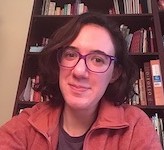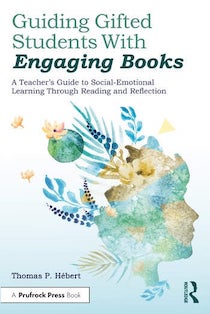SEL Reading & Reflection for Gifted Students
Guiding Gifted Students With Engaging Books: A Teacher’s Guide to Social-Emotional Learning Through Reading and Reflection
By Thomas P. Hébert
(Routledge/Prufrock Press, 2022 – Learn more)
Reviewed by Amy Estersohn

In this book professor Thomas P. Hébert identifies SEL issues that teachers of the gifted say they wish they had better support for. Those issues include dealing with disappointment, celebrating one’s uniqueness, and underachievement.

Milo struggles to follow the doctor’s directions exactly, and when the book instructs him to turn the page if he wasn’t able to follow the instructions, Milo finds a note that says, “CONGRATULATIONS! YOU’RE NOT PERFECT!” (Manes, 71).
This book provides young elementary school students a way to discuss perfectionism without having to bring up personal incidents, and by reading about Milo’s journey to be perfect, it allows young readers to see that perfect doesn’t mean anything much after all.
Sharon Creech’s Chasing Redbird (1997) is a journey story for an upper elementary or middle school student and is also featured in the appendix. The writing is lyrical and emotionally sensitive, and the protagonist, Zinnia, is an outsider even to her own family and is wracked with guilt over a cousin’s death and the recent passing of an aunt. This book shows that sometimes you have to go within and “make your own trail” to find yourself and your own interpretations of life’s events. The book is perfect for a reader who finds themselves alone in their thoughts a lot – or a reader who wants a good cry (or five).
For students looking for a lighter touch, it’s hard not to laugh at Surviving the Applewhites by Stephanie S. Tolan (2002), where a quirky family of artistic misfits find themselves coming together over a production of The Sound of Music, and juvenile delinquent Jake is made to feel at home in this bunch. This story celebrates giftedness, intensity, and being true to who you are in order to find community.
A more recent recommended text is The Unsung Hero of Birdsong, USA by Brenda Woods (2019) in which a young Gabriel befriends an older Mr. Meriwether Hunter and learns that Meriwether is an overlooked World War II hero. This text not only pairs well with history and social studies units, but it also features the kind of intergenerational friendship that many gifted students crave.
For older readers ready for darker themes, a text like Whirligig by Paul Fleischman (1998) is suggested. Readers may connect to Brent’s work to heal others without acknowledging his own need for healing. This book reminds readers that pain is a part of life and that being true to ourselves can be healing and serve as inspiration and hope for others. Gifted readers will likely be more in-tune with this intricate narrative.
Real teachers, real texts, real activities
It is clear that gifted students benefit from a variety of texts that touch upon topics, themes, and emotions that might not be of interest to a general population. Hébert provides vignettes across six different classrooms to demonstrate how different teachers used some of the texts he identifies to engage their readers.
Each chapter has a vignette about the classroom and the rationale for the text chosen, a list of discussion questions, and a list of follow-up activities that pair with the text. These example activities are helpful for teachers in a rush who want to use this book to bolster their own lesson planning and unit planning.
So what, now what?
While the lists of questions and activities were helpful to understanding how one person may teach the text, I would have been even more interested in reading some reflection and follow-up from the teachers who taught these units on what they thought went well and what they would have changed in a future unit.
At a distance, it was difficult to determine where teachers were using these texts over the course of their school year, what units shifted or were eliminated when this new reading unit was introduced, and whether they would consider doing the unit again, but maybe under different circumstances.
I also had a difficult time assessing the efficacy of the unit. I felt that many of the works of literature highlighted in this book were carefully chosen to appeal to a gifted audience, but what did the students think? Did these books reach them emotionally and psychologically as intended? How did they make meaning out of these titles?
I believe this text is worth having and sharing, if only for the appendix of recommended titles. However, to put this book into practice in a gifted classroom still requires more work.
Amy Estersohn is a teacher and college admissions consultant. Her website is www.leadwithtalents.com






























